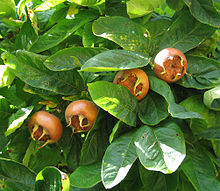Mespilus
| Mespilus | |
|---|---|
 |
|
| Common medlar foliage and fruit | |
| Scientific classification | |
| Kingdom: | Plantae |
| (unranked): | Angiosperms |
| (unranked): | Eudicots |
| (unranked): | Rosids |
| Order: | Rosales |
| Family: | Rosaceae |
| Subfamily: | Amygdaloideae |
| Tribe: | Maleae |
| Subtribe: | Malinae |
| Genus: |
Mespilus Bosc ex Spach |
| Species | |
Mespilus canescens
Mespilus germanica
Mespilus, commonly called medlar, is a monotypic genus of flowering plants in the family Rosaceae containing the single species Mespilus germanica of southwest Asia. A second proposed species, Mespilus canescens, discovered in North America in 1990, proved to be a hybrid between M. germanica and one or more species of hawthorn, and is properly known as ×Crataemespilus canescens.
Mespilus are deciduous large shrubs to small trees growing up to 8 metres (26 ft) tall. The fruit is a matte brown pome.
Mespilus germanica is apparently native only to southwest Asia and southeastern Europe, i.e. near the Black Sea coast and western Mediterranean, and Asia Minor, as well as the Caucasus and northern Iran, but it has an ancient history of cultivation and wild plants exist in a much wider area; it was grown by the ancient Greeks and Romans, beginning in the second century BC. Mespilus germanica was a very popular fruit in Western Europe during the Middle Ages, but has fallen out of favour there.
The medlar is referenced in William Shakespeare's comedy, As You Like It, Act III, scene ii, lines 117-120 in an engaging repartee between Rosalind and Touchstone, the Fool.
Within subfamily Amygdaloideae, Mespilus is most closely related to Crataegus, Amelanchier, Peraphyllum, and Malacomeles.
...
Wikipedia
